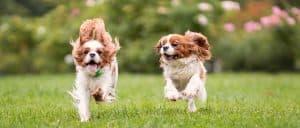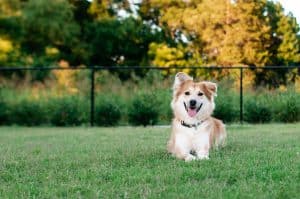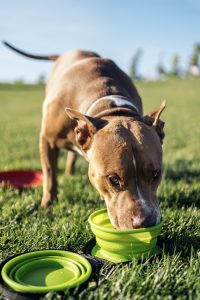
Etiquette Series: Dog Park Etiquette Explained
Is the dog park right for your dog? Rules, tips, and etiquette every pet parent should consider before heading to the dog park.
Allowing your dog to run freely off-leash with other dogs at a park can meet several of their needs: Socializing, spending energy, enrichment, and instinctual play. Rules are often hung at dog parks where everyone can read them; Sometimes they go unnoticed and sometimes they might not make sense. There might even be unspoken rules that make taking your dog to the park a little safer and easier. We’ve put together some basic dog park rules and tips, along with their explanations to help you better understand dog park etiquette.
Dog Park Rules
These are the basic l rules you would find at a dog park, although the park you are going to may have its own unique set of rules to follow. Make sure to read the rules before you enter the park. You might even be able to look them up online for the specific dog park you are attending. We’ve added some explanations to each rule to help you understand why the rule is in place.
1. Dogs visiting the dog park should have all their vaccinations.
Dogs entering the dog park can pick up illnesses and diseases from other dogs and their poop. To prevent your dog from getting sick, make sure they are up to date on all their vaccines. If you have a puppy, wait 7-10 days after their final round of vaccinations to enter the dog park. Always ask your veterinarian for proper protocol.
2. Do not bring dog or human food or treats into the dog park.
Your dog might not have food aggression, but other dogs might, especially when surrounded by other dogs. This can be dangerous for dogs and humans in the dog park.
3. Toys may not be allowed inside a dog park.
Sometimes dogs can become aggressive when fetching or playing tug with dogs they don’t know. If your dog loves to fetch, a dog-designated open space with a lot of land might be a better fit for fetching or tugging than a smaller, crowded, and fenced dog park.
4. Pick up your dog’s poop.
It can easily spread diseases like parvovirus, and parasites like worms. Dogs and people can also step in it, plus, it’s toxic to our water systems & soil. Read this article about why dog poop is different from wildlife poop.
5. No dogs in heat.
Not only could this cause an unplanned litter, but it can also cause serious aggression between dogs.
6. No small children.
Depending on the park, small children may not be permitted, or they must be in a child carrier off the ground, away from dogs. Small children do not have their own defenses or understanding of dogs and could get seriously injured at a dog park.
Tips to Make You and Your Dog’s Dog Park Experience Better
Pick a time that isn’t busy.

The first thing we recommend is to head to the park at a time it’s less likely to be busy, especially if your dog is new to that park. This may require you to check out the park a couple of times before you take your dog.
Take a lap or two before you go.
Before you enter the dog park it is best to take your dog on a walk to take the edge off their energy. This is especially helpful for dogs who are excitable and “know” when you are going to the park.
Communicate with other pet parents.
When your dog is playing with another dog, try to find their parent and stand in the vicinity of them. Ask them about their dog’s play style and see if your dog is a good match. Every dog is different and you don’t have to educate other people you don’t know about dog park etiquette. Just lead by example, be a responsible pet parent, advocate for your dog, and know that it is okay to separate two dogs whose playstyles don’t jive.
Make dog park parent friends.
If your dog makes a friend or two who they really enjoy playing with, ask their parent(s) if they’d like to meet up again at a similar time to get the dogs together for a playdate. Finding dogs who get along together can bring a lot of joy, exercise, and mental stimulation to your dog’s life.
Water. 
Always bring water and a water bowl with you just in case it isn’t accessible or if you’d rather your dog not share a water bowl.
Watch the weather.
Rain isn’t the only type of weather that could make a day at the park unenjoyable. Days that are too hot or too cold can be problematic for your dog. Heat stroke, burned paw pads, and freezing weather are all real causes for concern.
Keep your leash on you.
Always keep your leash with you while your dog is playing just in case you need to extract them quickly from a situation.
Think twice about taking your puppy – even if they are vaccinated.
Unless there is a separate and fenced area for small dogs, it is safest not to bring young puppies to the dog park. Instead, try socializing them together with other puppies or calm, playful adult dogs, in a backyard or at group training classes as long as long as they all have their vaccinations. Playtime with older pups can teach your puppy good behavior. We encourage you to find a more relaxed and controlled setting for this type of play. Watch this KONG Classroom video to better understand what it really means to socialize your dog.
Keep an eye on your dog while they are at the park.
Never leave your dog unattended at the dog park. Watch how they are playing with other dogs. If things get too rowdy, you could prevent a fight by taking your dog out of a situation. If your dog is isolating itself from the other dogs and not interested in playing, exploring, or sniffing around, this may be a sign that your dog doesn’t enjoy the dog park. Try taking your dog on a one-on-one play date or a long, sniffy walk, instead.
Watch your dog’s and other dogs’ body language.
If you notice a dog’s body stiffening, teeth showing, a locked gaze, or raised hackles, it’s time to break up the party and separate your dog from the crowd. Read this article about understanding your dog’s body language before you take your dog into any social situation.
Teach your dog “Recall” or the “Come When Called” command.
Working on your dog’s recall will help at the dog park by calling them back when it’s time to go, or if they are caught in a large group of dogs. While you will teach and reward this trick at home with treats, at the dog park you will use praise for a reward, like a happy voice and lots of pets. Find the KONG Classroom video demonstrating the Hand-Nose Touch Command here!
You can help create a safe space at the dog park by following the rules, knowing the right etiquette, and understanding your dog’s behavior before you go. We hope that by educating pet parents, we can help you determine if visiting the dog park is right for you and your dog!
 from Laurel Lewis
from Laurel Lewis



